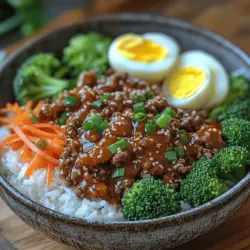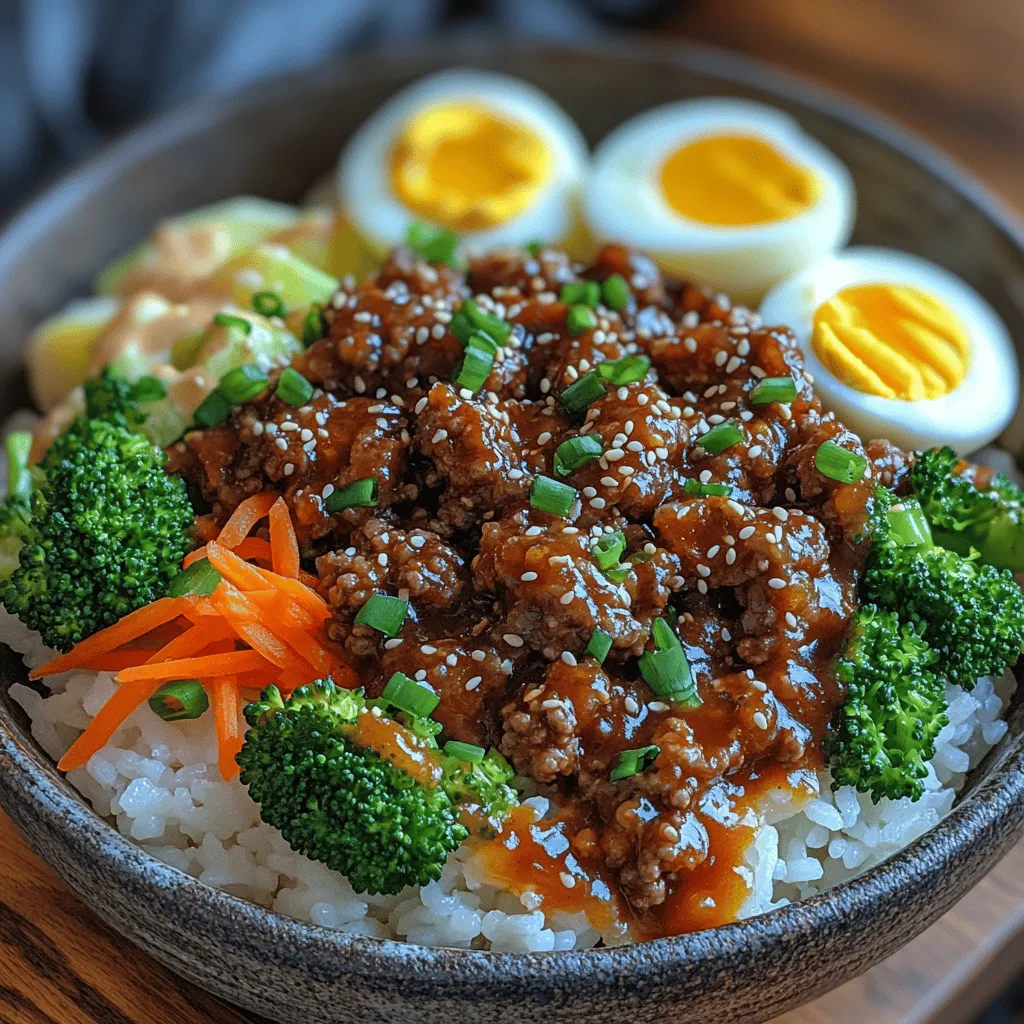Introduction
Korean cuisine has gained immense popularity over the years, captivating the taste buds of food enthusiasts around the globe. Its unique blend of flavors, textures, and colors sets it apart from other culinary traditions. From spicy kimchi to savory bulgogi, Korean dishes are known for their bold profiles and health-conscious ingredients. Among these delightful offerings, Korean Beef Bowls with Sesame Sprinkles stand out as a deliciously balanced meal that brings together juicy beef, vibrant vegetables, and aromatic seasonings.
Korean Beef Bowls are not just a feast for the palate; they also present a harmony of flavors and textures. The richness of marinated beef complements the crispness of fresh vegetables, while fragrant sesame sprinkles add a finishing touch that elevates the dish. This recipe is not only satisfying but also packed with nutritional benefits. Ground beef provides essential protein, while the colorful vegetables contribute vitamins, minerals, and fiber. The combination of these elements makes Korean Beef Bowls an excellent choice for a hearty and wholesome meal.
In this article, we will explore the ingredients that make this dish special, followed by detailed, step-by-step instructions to guide you in creating your own Korean Beef Bowls at home.
Understanding the Ingredients
Beef Marinade Essentials
The foundation of any great Korean Beef Bowl lies in the marinade, which infuses the beef with rich flavors that are quintessential to Korean cuisine. For this recipe, it is crucial to use quality ground beef that boasts an 80/20 fat ratio. This balance ensures that the beef is juicy and flavorful without being overly greasy. The right amount of fat enhances the dish’s overall taste and texture, making each bite a savory delight.
One of the key components of the marinade is soy sauce, which serves as a cornerstone of umami flavor in many Asian dishes. It brings a salty depth that complements the natural richness of the beef. Coupled with brown sugar, which adds a touch of sweetness and caramelization when cooked, the marriage of these two ingredients creates a complex flavor profile that is both satisfying and memorable.
Garlic and ginger are also essential in this marinade, contributing aromatic depth that elevates the dish. Garlic brings a pungent kick, while ginger adds warmth and a hint of spice. Together, they create a fragrant base that enhances the overall experience of Korean Beef Bowls.
Another key ingredient is sesame oil, which imparts a nutty flavor and fragrant aroma. A small amount goes a long way in enriching the marinade, making the beef even more irresistible. Lastly, the inclusion of gochujang, a fermented Korean chili paste, introduces a layer of spiciness and a slight tang that balances the sweetness of the brown sugar. Gochujang is a staple in Korean cooking, and its distinct flavor is what sets this dish apart from others.
Vegetable Components
In addition to the beef, the vegetable components of Korean Beef Bowls play a significant role in both flavor and nutrition. Common vegetables used in this dish include broccoli, carrots, and red bell peppers. Each of these vegetables brings its unique health benefits to the table.
Broccoli is rich in vitamins K and C, fiber, and various antioxidants, making it a powerhouse of nutrition. Carrots, known for their beta-carotene content, not only contribute a vibrant orange color but also provide important nutrients that support eye health. Red bell peppers are packed with vitamin C, which can bolster the immune system, and their sweet flavor pairs beautifully with the savory beef.
When preparing these vegetables, it is essential to preserve their nutrients and enhance their flavors. Steaming is an excellent method for cooking vegetables, as it retains their crispness and nutritional content. However, sautéing or stir-frying can also be effective, allowing the vegetables to absorb some of the flavors from the beef and marinade.
Feel free to experiment with other vegetables as well; snap peas, bok choy, or zucchini can add variety and additional nutrients to your Korean Beef Bowls.
Rice as the Base
Rice is an integral part of Korean cuisine, serving as the base for many dishes, including these beef bowls. The choice of rice can significantly impact the dish’s flavor and health benefits. Jasmine rice, known for its aromatic qualities and slightly sticky texture, pairs wonderfully with the rich flavors of the beef and the crunch of the vegetables. It absorbs the marinade beautifully, creating a cohesive dish.
Alternatively, brown rice is a fantastic option for those seeking a healthier alternative. Brown rice retains its bran and germ layers, providing more fiber and essential nutrients compared to its white counterpart. While it has a nuttier flavor and chewier texture, it offers a more wholesome base for the beef bowls.
Both types of rice can be prepared using a rice cooker or stovetop method, ensuring a fluffy and perfectly cooked grain to accompany the savory beef.
Step-by-Step Instructions
Marinating the Beef
The first step in creating your Korean Beef Bowls is to marinate the beef to allow the flavors to penetrate deeply. Begin by combining the marinade ingredients in a bowl: soy sauce, brown sugar, minced garlic, grated ginger, sesame oil, and gochujang. Whisk these together until the sugar is dissolved, creating a well-blended mixture.
Next, place the ground beef in a large mixing bowl and pour the marinade over it. Using your hands or a spatula, gently mix the beef and marinade until the meat is evenly coated. It’s important to ensure that all of the beef is enveloped in the flavorful mixture, as this will enhance the taste of the final dish.
For optimal flavor, cover the bowl with plastic wrap or transfer the beef to a resealable plastic bag. Let it marinate in the refrigerator for at least 30 minutes, although longer (up to 2 hours) will yield even better results. This marinating time allows the beef to absorb the marinade’s flavors, resulting in a more flavorful and tender meat.
Preparing the Vegetables
While the beef marinates, it’s time to prepare the vegetables. Start by washing and chopping the broccoli into small florets, slicing the carrots into thin rounds, and dicing the red bell pepper into bite-sized pieces. For a vibrant dish, try to keep the vegetable pieces uniform in size to ensure even cooking and an appealing presentation.
To retain the nutrients and crispness of the vegetables, steaming is a great method to consider. Fill a pot with an inch of water and place a steamer basket inside. Bring the water to a boil, then add the chopped vegetables to the steamer basket. Cover and steam for about 4-5 minutes, or until the vegetables are bright in color and tender yet still crisp. Avoid overcooking, as the goal is to maintain their texture and nutritional value.
If you prefer a bit more flavor, you can sauté the vegetables in a pan with a splash of sesame oil or a touch of the marinade for a minute or two. This method allows the vegetables to soak up some extra flavor while still retaining their crunch.
Cooking the Beef
Once the beef has marinated and the vegetables are prepared, it’s time to cook the beef. Heat a large skillet or wok over medium-high heat and add a drizzle of oil to prevent sticking. Once the oil is hot, add the marinated ground beef to the skillet. Use a spatula to break the beef apart as it cooks, ensuring even browning and moisture retention.
Cook the beef for about 5-7 minutes, stirring occasionally, until it is browned and fully cooked. The goal is to achieve a slightly caramelized exterior while keeping the inside juicy and flavorful. Be mindful not to overcrowd the pan, as this can cause the beef to steam rather than sear.
As the beef cooks, you can also incorporate the steamed or sautéed vegetables, allowing them to warm through and meld with the beef flavors. This step not only enhances the taste but also creates a visually appealing dish with vibrant colors.
With all components cooked and ready, you can now assemble your Korean Beef Bowls, combining the flavorful beef with your choice of rice and garnishing with sesame sprinkles for that final touch of flavor and texture.
Stay tuned for the next part of this article, where we will delve into the finishing touches and tips to make your Korean Beef Bowls truly exceptional!
Importance of Breaking the Beef Apart for Optimal Texture
When preparing Korean Beef Bowls, achieving the perfect texture is crucial for the overall enjoyment of the dish. Breaking the beef apart during cooking allows it to sear evenly, developing a beautiful caramelization that enhances flavor. It also helps to create a more tender bite, making each mouthful enjoyable. As the beef cooks, use a wooden spoon or spatula to break it into smaller pieces, ensuring that it is cooked through without becoming tough or chewy. This technique not only improves texture but also allows the marinade to penetrate the meat more effectively, infusing it with that distinct Korean flavor profile.
Assembling the Bowls
Once your beef is cooked to perfection, it’s time to assemble the bowls. The beauty of Korean Beef Bowls lies not just in their taste, but also in their presentation. To create a visually appealing and balanced meal, follow these guidelines:
1. Choose Your Base: Start with a generous scoop of cooked rice, preferably short-grain white rice or brown rice for a healthier option. Place the rice at the bottom of the bowl, as it will absorb the flavors from the beef and sauces.
2. Layering for Flavor Balance: Next, add a portion of the cooked beef on top of the rice. This not only allows the juices from the meat to soak into the rice but also creates a foundation for the other ingredients.
3. Add Vegetables: Incorporate your choice of vegetables, such as sautéed bok choy, shredded carrots, or fresh cucumber slices. These not only add color but also provide a refreshing crunch that contrasts with the tender beef.
4. Customizing Portions: Depending on dietary preferences, you can customize the portions in each bowl. For a lighter meal, reduce the beef and increase the vegetable portions. For those who prefer a heartier meal, add extra beef or serve alongside a fried egg for added richness.
Adding Toppings
To elevate your Korean Beef Bowls, consider adding various toppings that enhance both flavor and nutrition:
1. Green Onions and Sesame Seeds: Garnishing the dish with freshly sliced green onions adds a pop of color and a mild onion flavor that complements the beef. Sesame seeds, on the other hand, provide a nutty crunch and a visual appeal. Both toppings are traditional in Korean cuisine and contribute to the overall depth of flavor.
2. Optional Protein Boost: For those looking to increase the protein content, consider adding a boiled egg. A soft-boiled egg, with its runny yolk, can add a rich creaminess to the dish, tying all the flavors together beautifully.
Nutritional Information
Understanding the nutritional profile of your Korean Beef Bowls can help you appreciate this dish even more:
– Calories and Macronutrients: A typical serving of Korean Beef Bowls contains approximately 500 calories, depending on the portion sizes and ingredients used. It is generally composed of 30g of protein, 40g of carbohydrates, and 20g of fat, making it a well-rounded meal.
– Health Benefits of Ingredients: The lean cuts of beef provide high-quality protein essential for muscle building and repair. The vegetables add a wealth of vitamins, such as Vitamin C, which supports the immune system, and fiber for digestive health. Rice, especially if you choose whole grain, can provide sustained energy and essential nutrients.
Cultural Significance of the Dish
Korean Beef Bowls are more than just a meal; they represent a significant aspect of Korean culinary tradition.
1. Balance of Flavors: In Korean cooking, there is a strong emphasis on achieving balance in flavors—sweet, salty, spicy, and sour. This dish exemplifies that philosophy, as the sweetness of the marinade contrasts beautifully with the savory notes of the beef, while the freshness of the vegetables rounds out the experience.
2. Global Popularity: The rise of Korean cuisine on the global stage is undeniable. Dishes like Korean Beef Bowls have found their way into homes worldwide, showcasing the adaptability of Korean flavors to various dietary preferences. As more people discover the joys of Korean food, they are drawn deeper into its rich history and cultural significance.
Variations and Adaptations
Korean Beef Bowls can be easily adapted to suit different dietary needs and preferences:
1. Vegetarian and Vegan Options: For a meat-free version, consider substituting the beef with plant-based proteins such as tofu, tempeh, or seitan. Marinate these alternatives in the same sauce for a delightful flavor experience.
2. Incorporating Seasonal Vegetables: Take advantage of what’s in season by adding seasonal vegetables such as bell peppers, zucchini, or snap peas. These additions not only enhance the nutritional profile but also provide variety in flavor and texture.
3. Adjusting Spice Levels: If you or your guests prefer a milder dish, reduce the amount of gochujang (Korean chili paste) in the marinade or omit it altogether. Alternatively, if you enjoy a kick, consider adding extra chili flakes or fresh chilies to elevate the spice level.
Serving Suggestions
When it comes to serving Korean Beef Bowls, presentation and accompanying dishes play a significant role:
1. Family-Style Serving: Serve the bowls family-style, allowing everyone to customize their portions. Place large bowls of rice, beef, and vegetables on the table for a communal dining experience that encourages interaction.
2. Accompanying Side Dishes: Traditional Korean meals often include side dishes such as kimchi or pickled vegetables. These tangy accompaniments not only offer a contrast to the richness of the beef but also enhance the meal’s overall flavor profile.
3. Storing Leftovers: If you have leftovers, store them in an airtight container in the refrigerator for up to three days. When reheating, do so gently on the stovetop or microwave to maintain the flavors and textures.
Conclusion
Korean Beef Bowls are a delicious and versatile dish that can easily become a staple in your home cooking repertoire. With their rich flavors, balanced nutrition, and cultural significance, these bowls offer a gateway into the vibrant world of Korean cuisine.
Encouraging you to try making Korean Beef Bowls at home, this recipe provides not only a satisfying meal but also an opportunity to explore the depths of Korean flavors and cooking techniques. Whether you stick with the traditional recipe or adapt it to suit your dietary preferences, you’ll find that these bowls are not just a meal, but a culinary adventure waiting to unfold.



